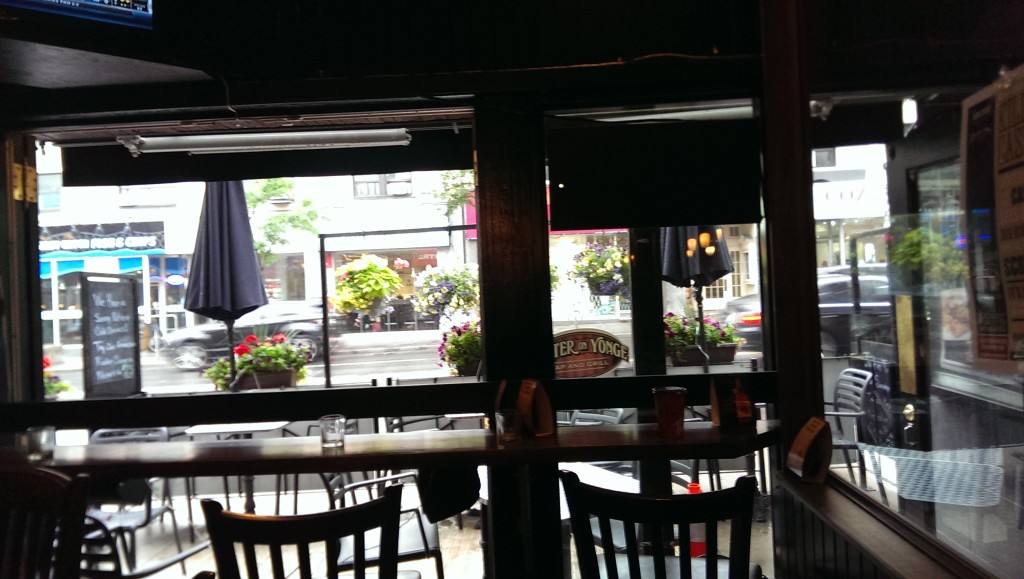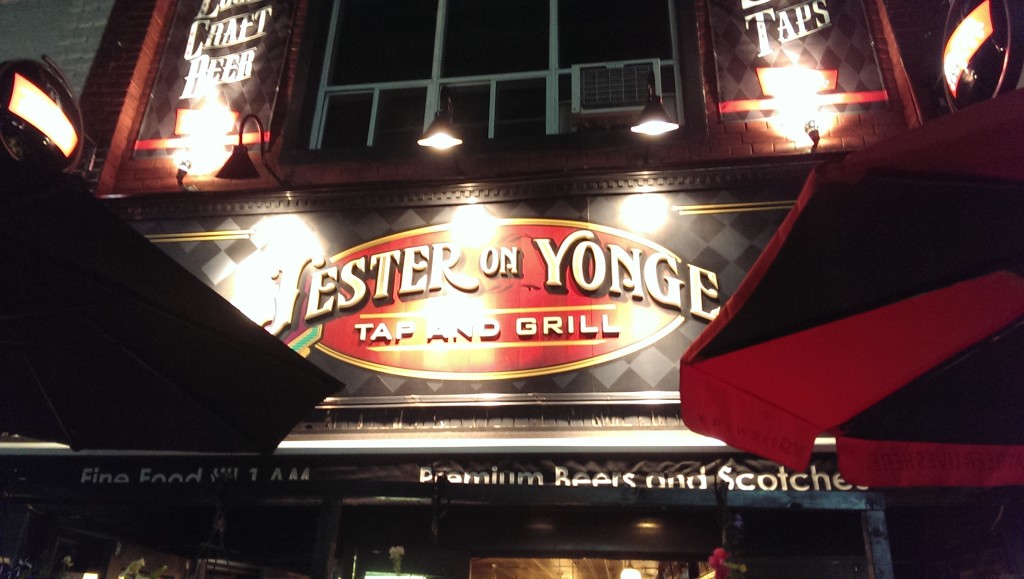On Sunday, I got out to the Jester on Yonge for a sampling event for the Bobcaygeon Brewery. It’s been at Yonge and St. Clair for about as long as I can remember, but currently they’re going through something of a resurgence. The owners have had the place for 15 years, and I can attest to how much that block has changed since I was a child.

Bobcaygeon Bitter Warrior APA would have fit in to the IPA rush of 2012 or so. It’s unbalanced in the direction of bitterness, but there is a nice grapefruit character. They’re brewed in Ottawa, based in Kingston and sold in Toronto. It seems like a lot of 401 travel to me.
At one point there were two movie theatres and Bregman’s bakery. Before the Fox and Fiddle, I’m pretty sure that corner at Heath was a McDonald’s (a high point of Friday afternoons when you’re let out of BSS early at seven years old. Yes, I went to an Anglican girls’ school until grade two. The running joke is that my parents wanted me to be an Anglican girl.) I’ve got fond memories of The Book Cellar, smelling simultaneously of new paperbacks and slightly moldering basement. One of my earliest food memories was seeing Caesar salad prepared tableside at Oliver’s on that block.
In 2000, the Jester on Yonge would have been one of the high points of the strip at Yonge and St. Clair. J.J. Muggs was a block south (and probably closed) and I’m pretty sure the same fate had befallen Toby’s Good Eats. In 2015, it faces stiff competition. There’s the Union Social Eatery and John and Sons Oyster House for upscale dining. There’s Holy Chuck and Easy Catch for upscale casual. The rest of the dynamic is odd because the pubs in the neighbourhood are pretty niche affairs. The Midtown Gastrohub was a Fox and Fiddle and now seems to be largely Molson taps in a bare minimum-effort bid for resurgence. They did have Detour when I stopped in the other night. Scallywags is always popular with the sports crowd, but I recall their most interesting offering being Tankhouse.

There’s something I love about the Toronto high street pub. It’s almost always a long rectangular box and if the space hasn’t been renovated since mid century, you can practically predict where the bathroom will be.
Until recently, The Jester was almost all Labatt taps. That might as well be suicide when faced with the demographic changes in the neighbourhood. They’re up to twenty-nine craft taps at the moment with a couple of mainstream offerings remaining. Typically when a bar makes that change, they’ll close down and renovate and re-launch with a new image, so it’s interesting to see the Jester making incremental progress towards their goal. They’re going to introduce a new food menu at some point in the very near future. They’re installing a stage for live music or comedy, which should add a feature to the neighbourhood that it doesn’t really have. They want to tread the line between being a local pub for the apartment and condo dwellers in the area and being a destination pub. It’s easier said than done, but I like their chances. They seem to be in good hands.
I was sitting there on Sunday talking to their consultant and thinking about one of the problems that we face: There aren’t enough taps in Ontario to support all the breweries that exist now. As we continue to add breweries, this is going to be a pretty serious problem. For that reason, I’m going to share some of the advice I gave them because I think it’s universally applicable and maybe it’ll help other people too.
Selection is important, but not in the way you think.
Quality is far more important than quantity. You probably don’t need more than twenty taps in order to make a go of craft beer. The important thing is to choose the selection so that you’ve got a good example of a number of different styles. Rotating taps will help with seasonal interest, but quality will move all year round. Beyond a certain point more is less and the kegs get old.
The condition of the taps is as least as important as the beer coming out of it.
Clean your lines every two to three weeks. Consider using plugs for your draught system. Flush the first 5-6 ounces of beer out of each line at the beginning of service every day. That sounds like a lot of spillage, but you’re better off taking a low margin hit on spillage than losing customers permanently. If you’re aiming to be a destination, you will lose customers to off flavours sure as the TTC shuts down for signal problems. If you own the pub, save some money in the long term by learning to clean and troubleshoot your own draught system. It’s also important, since you’ve gone to that trouble, to make sure the balance of detergent in the dishwasher is right. Don’t pour pristine beer and ruin it with chlorination.
Treating the glassware properly is more important than logos.
Every brewery worth their gypsum has branded glassware, but if you’ve got a lot of taps, that amounts to a lot of shelf space, glasses of different sizes and fragility, and inevitably uncertainty when someone gets served the right beer in the wrong glass during a rush. You’re better off investing in standard glassware in two sizes: 20 ounce nonic pint and 14 ounce tulip glass. 5 ounce glasses for samples and flights are a good idea if you want to go that way and have room. As a bonus, place the size of the glassware somewhere prominent. People like to know what they’re getting for their money.
Your menu is cheap to reprint.
If you’re a pub finding your niche, the temptation is to lean heavily on pub food classics. If you’ve hired good kitchen staff, they should be able to knock that stuff out blindfolded. It’s not the best use of those guys. Maybe you’ve got cooks from Sri Lanka or Guatemala or Mexico. Maybe they’re culinary school graduates. Maybe they’ve got hidden talents. If you let them cook things they’re interested in you’ll wind up with a menu no one else has and talented employees cooking to their strengths. If it doesn’t work out, you can go back to fish and chips and the “name of the pub” burger that inevitably has bacon and cheese.
Events are not a once a year affair.
I’m looking at the list of events for OCB week and I’ve got to say it: A special on a burger and a pint is not the kind of thing that’s going to draw people to your banner during a beer week. If you want the neighbourhood’s attention make that the Wednesday night special on a weekly basis. Kill the Cask? Make that happen once a month. You want to do a beer dinner? What the hell is the percentage in waiting for a beer week to do that. With a little promotion, you ought to be able to sell out a modestly sized beer dinner quarterly.
Get the word out.
I really can’t overstate the importance of social media. It’s important that people know what’s happening at your pub. It’s one thing to have a notice board on site with events: you should still have that. It’s quite another to be able to get peoples’ attention on an ongoing basis. If you can, documenting the changes you’re making is a good idea. “This is new on tap” or “We’re trying this dish out this week” are great ways to make people pay attention. This requires maintenance. Sending identical content out weekly will get you put on mute.
Finally, it needs to be said: success in running a pub is an ongoing process. All of the above items have to work together all the time in order for the place to succeed.
